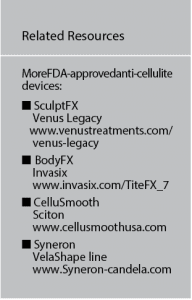The Skin and Aesthetics | March 2014 Plastic Surgery Practice
By Denise Mann
From kneading and massaging to laser therapy and injections, there’s little someone wouldn’t do, or at least try, if it meant getting rid of their cellulite for good. No potion, cream, or serum is too expensive if it promises to excise the lumpy, dimply fat pockets that can appear on buttocks, thighs, hips, abdomen, or elsewhere.
Unfortunately, most of what was out there until recently was about as potent and effective as snake oil, says Bruce E. Katz, MD, the director of Juva Skin and Laser Center in New York City and a Clinical Professor of Dermatology at Mount Sinai School of Medicine, and Director of the Cosmetic Surgery & Laser Clinic at Mount Sinai Medical Center.
But Cynosure’s Cellulaze may be the “cure” that has so far eluded the millions of people whose skin is marred by cellulite and the doctors who want to treat them. Katz was the first US dermatologist to use the device, and as such has one of the largest clinical experiences with Cellulaze.
Cynosure received federal Food and Drug Administration (FDA) 510(k) clearance for Cellulaze Cellulite Laser Workstation in January 2012.
Now more than 2 years since the FDA nod with even more cases and experience under his belt, Katz is still bullish on Cellulaze. He discussed Cellulaze and our ever-evolving understanding of the pathophysiology of cellulite with PSP. Here’s what we learned:
PSP: The understanding of how cellulite forms has evolved over time. What do we know today?
BK: There are three structural changes that take place and produce cellulite. There is fat that herniates through the dermis and causes the raised areas or hills. The “valleys” are caused by fibrous bands that connect skin to muscle, and thirdly, the laxity of the dermis allows both of these things to happen.
PSP: What causes a patient to develop cellulite?
BK: It is a multifactorial condition. Hormonal changes, genetics, age, gender, and skin quality can all affect the development of cellulite. A patient can be overweight or obese and have cellulite, but many thin individuals also develop cellulite.
PSP: Explain how the Cellulaze procedure works.
BK: The doctor inserts a small cannula under the skin, and we fire laser thermal energy to the areas to be treated. The laser releases the areas of skin depression and increases the elasticity and thickness of the skin.
PSP: How does Cellulaze address these structural changes?
BK: Cellulaze attacks cellulite—at its source. It works under the skin’s surface to address all aspects of cellulite (septea, bulging fat, and loose skin), whereas other treatments work over the skin’s surface and cannot address all three issues at the same time.
PSP: Is there a learning curve for new Cellulaze users?
BK: It is easier to use a surface treatment, so yes, there is a learning curve because Cellulaze goes beneath the skin.
PSP: And the million-dollar question: Does Cellulaze really work?
BK. Yes. Read the studies. The data is real. Cellulaze is the gold standard for cellulite treatment. It has really been the only major new treatment for cellulite in recent years. I just conducted a study using Vectra 3D imaging to show qualitative, quantitative, and credible results on the “hills” and “valleys” of cellulite. There is no question that we get good results with Cellulaze that last for at least 6 months, and unpublished data shows that the results last for as many as 3 years.
PSP: What degree of improvement can the average patient expect to see after Cellulaze?
BK: About a 70% to 80% improvement, depending on the individual and what kind of shape they are in. Women who have sun damage don’t do as well because they are unable to produce new collagen.
PSP: Can anyone with cellulite tolerate Cellulaze, in your opinion?
BK: Yes. Anyone can tolerate this treatment. We use a local anesthesia. It is completely safe. There will be some bruising and swelling afterward.
PSP: What about some of the other devices that claim to get rid of cellulite? Do they work?
BK: They work, but multiple sessions are needed and the results don’t last as long as what we see with Cellulaze.
PSP: Speaking of multiple sessions, is Cellulaze really a “one and done” procedure?
BK: Yes. Patients get one treatment, and their cellulite is gone—just like that. Voila!
Denise Mann is the editor of Plastic Surgery Practice. She can be reached at [email protected].
Original citation for this article: Mann, D. Smooth grooves: Is there finally a cellulite cure?, Plastic Surgery Practice. 2014; March: 26-27.





